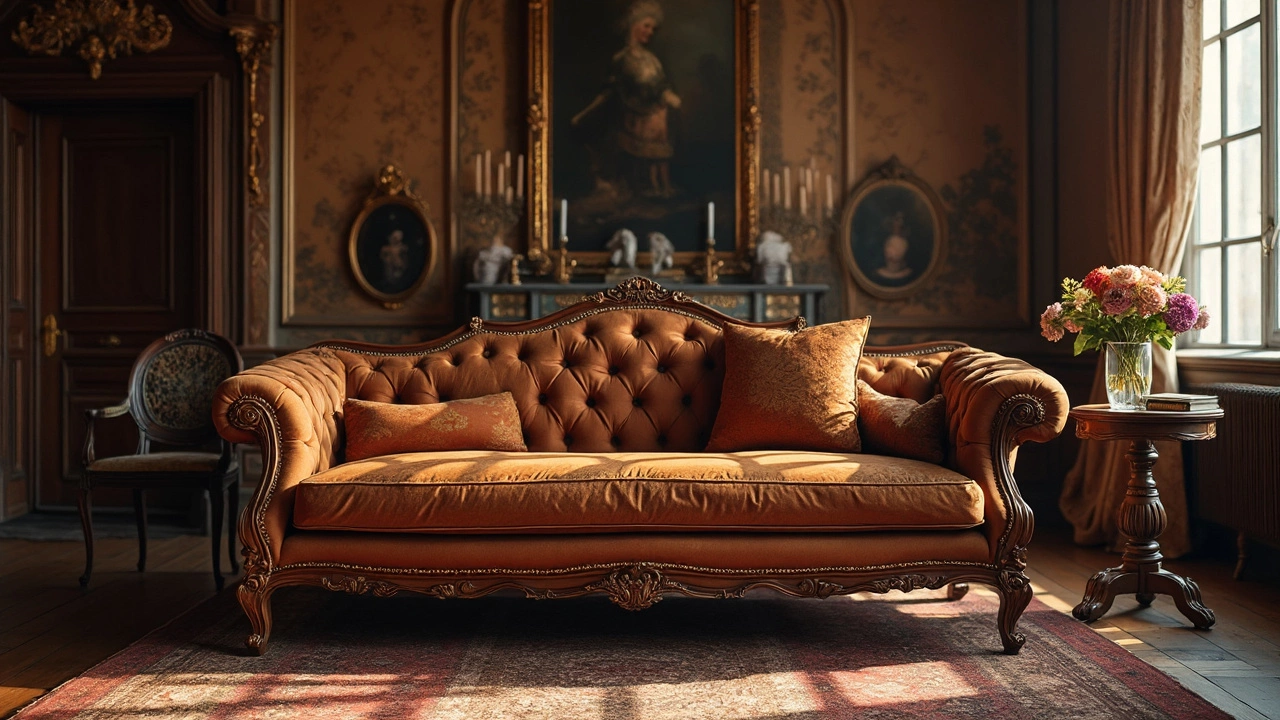How Many Years Should a Sofa Last?
 Apr, 15 2025
Apr, 15 2025
So, you've probably wondered at some point: How long should my sofa really last? It's more than just a piece of furniture; it's where you crash after a long day, binge-watch your favorite shows, or maybe even sneak in a nap or two. Getting the most life out of your sofa isn't just about good luck; it involves a little knowledge about materials, construction, and some smart care habits.
On average, a good-quality sofa might stick around for 7 to 15 years. But, of course, it can vary quite a bit. The key? Materials and how you treat it day-to-day. Leather sofas, for instance, can often outlast their fabric counterparts if you give them the right care. On the flip side, a cheaply made frame might start creaking long before you're ready to say goodbye, no matter how nice the upholstery looks.
- Understanding Sofa Lifespan
- Materials Make a Difference
- Construction Quality Counts
- Everyday Sofa Care Tips
- When to Consider Replacement
- Making the Most of Your Sofa Investment
Understanding Sofa Lifespan
When it comes to the lifespan of a sofa, multiple factors come into play, such as the quality of materials, how often it's used, and how well it's cared for. On average, a sofa's expected lifespan can range from 7 to 15 years.
So why such a broad range? Well, it often boils down to the details. The frame is the backbone of the sofa, so to speak. Solid hardwood frames are often the gold standard, offering durability that can handle everyday wear and tear. Contrast this with particleboard or cheap plywood, which might barely make it to the lower end of the lifespan spectrum.
| Material | Average Lifespan (Years) |
|---|---|
| Leather | 15+ |
| High-Quality Fabric | 10-15 |
| Low-Quality Fabric | 5-10 |
Then, there's the cushioning. High-resiliency foam is often a good choice for both comfort and longevity. If you don't want sagging cushions after just a few years, invest in quality materials. Upholstery also plays a role. Leather, if well-maintained, can last longer than many fabric options and even look better with age.
A key part of your sofa's longevity is how you treat it. Regular cleaning, avoiding harsh sunlight, and not using it as a trampoline can help extend its life. So, consider these factors when debating whether your sofa is nearing its end or still has some years to give.
Materials Make a Difference
Alright, let's chat about what makes a sofa really last: the materials. Picking a sofa isn’t just about what looks good; it’s about what’ll survive your living room adventures. You know those marathon movie nights, kid jumping sessions, and all the foot traffic. The right materials can mean the difference between a couch that sticks around for a decade and one that’s sagging by next summer.
First up, leather sofas are often the champions of durability. They're tough, fairly easy to clean, and they age like a fine wine. Sure, you might spend a bit more upfront, but if treated well, a leather sofa can outlast many other types, sometimes by a decade.
Next, let's look at fabrics. Natural fibers like cotton and linen are comfy and breathable but might wear quicker if they’re in a high-use area. Synthetic blends offer a bit more resistance to stains and wear, but they might not have that soft touch you adore. So, if durability is your game, look for a fabric with a higher thread count and maybe even a performance fabric that's built to resist spills and stains.
For the eco-conscious folks out there, there’s even more to consider! Recycled materials and sustainably sourced fabrics are popping up in the sofa market, offering a more earth-friendly option without sacrificing on toughness.
And here's a little insider tip: always, always check the cushion filling. High-density foam can stay firm and comfortable much longer than the lower density kind. Memory foam is also a solid choice but can be more expensive. In the end, think of your sofa as an investment.
Here's some quick stats if you're into numbers: Research shows that investing in quality materials could prolong your sofa's life by up to 50%! So, keep an eye on what you’re buying. A little knowledge can save a lot of headaches (and cash) down the road.
Construction Quality Counts
Alright, let's dig into what really can make or break a sofa's lifespan: its construction. You might think a sofa is just about style and comfort, but what's inside is what really counts. A well-constructed sofa can hold up against those lively game nights and lazy Sunday afternoons.
The frame is the backbone, literally. If you want a sofa that’s going to last, look out for a solid wood frame, like kiln-dried hardwood. This helps prevent warping and cracking over time. Avoid particle board or plastic—those tend to give up the ghost much earlier.
Next up, consider the joints. A quality sofa will have joints that are glued, dowelled, and screwed together, not just stapled or nailed. This adds durability and keeps everything nice and tight over the years.
Let’s not forget about the cushions. High-density foam wrapped in a layer of polyester or down offers comfort that doesn’t sag too quickly. Also, a good quality suspension system, such as coiled springs, will provide better support than cheaper alternatives like mesh or webbing.
Just to give you an idea of longevity, here's a quick comparison:
| Material | Expected Lifespan (Years) |
|---|---|
| Solid Hardwood Frame | 15-20 |
| Particle Board Frame | 5-10 |
| High-Density Foam Cushions | 7-10 |
| Low-Density Foam Cushions | 3-5 |
So next time you're picking out a sofa, give some attention to what’s beneath the surface. Investing in solid construction can save you money and hassle in the long run, making your living room feel comfy and welcoming for years to come.

Everyday Sofa Care Tips
Taking care of your sofa doesn’t have to be a hassle. A little regular maintenance goes a long way in ensuring your couch remains comfy and stylish for years. Here's a no-fuss guide to keeping your sofa in top shape.
Start by giving your couch a quick clean every week. Run a vacuum with an upholstery brush over the whole thing to pick up dust, crumbs, and pet hair. If you've got a leather sofa, a damp cloth should do the trick, but make sure it's dry before you sit down.
- Plump and Flip Cushions: Fluff up and rotate your cushions once a week. This prevents sagging and keeps the wear even. Plus, it helps those well-used spots bounce back into shape.
- Spot Clean: Accidents happen, right? For those unexpected spills, dab — don’t rub — the stain with a clean cloth. Check the tags on your sofa for specific cleaning instructions, though. Some fabrics need a bit more TLC.
- Sun and Heat Protection: Keep your couch away from direct sunlight and heat sources to prevent fading and fabric damage. If that’s not possible, using a sofa cover can help shield it from the harsh rays.
- Frame Check: Every now and then, take a peek to ensure the frame's holding up well. Tighten any loose screws you come across, especially if it's a wooden frame. You don't want creaks to turn into cracks over time.
Finally, remember that little extras go a long way. Investing in a slipcover or decorative throw can help protect the original fabric and add a bit of flair. Keeping your sofa in top-notch condition doesn't require much — just a pinch of regular care and a dash of attention.
When to Consider Replacement
Deciding when it's time to say goodbye to your sofa can be a bit tricky. But there are some clear signs that can help you make that call. Let's face it, no one wants to sit on a sagging, creaky couch that looks like it survived a hurricane. Sometimes, though, it's hard to let go until you know for sure it's time.
First up, let’s talk comfort. If you're sinking into the cushions a bit too much, or worse, feeling the frame, that's a red flag. Construction quality matters and when it's compromised, comfort goes out the window. Another sign? Noise! If your sofa sounds like it's complaining every time you sit, it might be a warning that the structure is on its last legs.
Look closely at the materials too. If the fabric is torn, stained beyond repair, or shows frayed edges everywhere, it's probably time for a fresh start. With leather, check for cracks or peels. Aesthetics play a big role in how much love you’ve got left for your sofa. Besides, a worn-out look isn’t just about style—materials that are falling apart can't protect the sofa's insides, meaning the whole structure might not last long.
Another practical cue to consider: lifestyle changes. New pets, kids, or a different living space might mean your current sofa no longer fits your needs or style. Maybe you've redecorated, or maybe that bulky behemoth of a couch hogs more space than it’s worth in your new apartment.
Let's not forget about value for money. If you've had your sofa for over a decade sans major maintenance, you're probably getting close to the replacement point. Sure, a long-lasting sofa is the dream, but once repairs cost more than a new unit would, it's wiser to invest in something new.
Finally, consider health. Sofas can accumulate allergens over time—dust mites, pet dander, you name it. If you're noticing more sneezing around your couch than anywhere else, it could be the prime suspect. A fresh, clean start might be what's needed for both comfort and health.
Replacing your sofa is a big step but listening to these signs can help ensure you're always lounging in style and comfort.
Making the Most of Your Sofa Investment
Getting real value out of your sofa doesn't require rocket science, but a little strategy goes a long way. Think of your sofa as more than just a comfy seat; it's an investment in your home. Let's explore some practical ways to keep your furniture durability in check and make that couch last longer.
First up, consider placement. Where you put your sofa can make a huge difference. Keep it away from direct sunlight and intense heat — these can cause fading and wear over time, especially for fabrics.
Next, regular cleaning is your best friend. Fabric sofas benefit from a vacuum once in a while to get rid of dust and crumbs. If you've got leather, invest in a good leather conditioner. It keeps the material supple and prevents cracks.
Don't ignore the cushions. Flip and rotate them weekly to even out wear and give them a fluffing while you're at it. This simple step can keep them looking fresh and bouncy.
- Materials Matter: Choosing the right fabric or leather can add years to your sofa's life. For families or pet owners, durable fabrics like microfiber or leather are smart bets.
- Protective Covers: They may not look glamorous, but covers can protect your sofa from spills and stains, especially in high-traffic rooms.
- Proper Support: Ensure your sofa sits on a stable and even floor. If the floor is uneven, use shims or adjust the sofa legs to prevent warping over time.
Investing in a sofa is no small decision. With these simple steps and some mindful care, not only will your sofa lifespan increase, but you'll also save money and hassle in the long run.